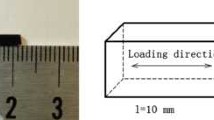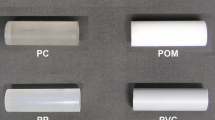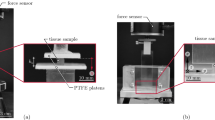Abstract
Compressive stress-strain response of porcine muscle was experimentally determined at intermediate strain rates (100/s-102/s) in this study. A hydraulically driven materials testing system with a dynamic testing mode was used to perform the compressive experiments on porcine muscle tissue with loading directions parallel and perpendicular to muscle fiber direction. Experiments at quasi-static strain rates were also conducted to investigate the strain-rate effects over a wider range. The experimental results show that, at intermediate strain rates, the porcine muscle’s compressive stress-strain responses are non-linear and strain-rate sensitive. The porcine muscle’s compressive mechanical response exhibits no significant difference between the two fiber orientation cases at quasi-static and intermediate strain rates. An Ogden model with two material constants was adopted to describe the rate-dependent compressive behavior of the porcine muscle.








Similar content being viewed by others
References
Yamada H (1970) Strength of Biological Materials. Lippincott Williams & Wilkins, Baltimore
Fung Y (1993) Biomechanics. Mechanical Properties of Living Tissues. Springer-Verlag, New York
Bosboom E, Hesselink M, Oomens C, Bouten C, Drost M, Baaijens F (2001) Passive transverse mechanical properties of skeletal muscle under in vivo compression. J Biomech 34:1365–1368
Pinto J, Fung Y (1973) Mechanical properties of the heart muscle in the passive state. J Biomech 6:597–616
Hawkins D, Bey M (1997) Muscle and tendon force-length properties and their interactions in vivo. Journal of Biomehcanics 30:63–70
van Loocke M, Lyons C, Simms C (2006) A validated model of passive muscle in compression. J Biomech 39:2999–3009
van Loocke M, Simms C, Lyons C (2009) Viscoelastic properties of passive skeletal muscle in compression-cyclic behaviour. J Biomech 42:1038–1048
van Loocke M, Lyons C, Simms C (2008) Viscoelastic properties of passive skeletal muscle in compression: Stress-relaxation behaviour and constitutive modelling. J Biomech 41:1555–1566
Takaza M, Moerman K, Gindre J, Lyons G, Simms C (2013) The anisotropic mechanical behaviour of passive skeletal muscle tissue subjected to large tensile strain. J Mech Behav Biomed Mater 17:209–220
Morrow D, Haut Donahue T, Odegard G, Kaufman K (2010) Transversely isotropic tensile material properties of skeletal muscle tissue. J Mech Behav Biomed Mater 3:124–129
Gennisson J, Deffieux T, Macé E, Montaldo G, Fink M, Tanter M (2010) Viscoelastic and Anisotropic Mechanical Properties of in vivo Muscle Tissue Assessed by Supersonic Shear Imaging. Ultrasound Med Biol 36:789–801
Borg T, Caulfield J (1980) Morphology of connective tissue in skeletal muscle. Tissue Cell 12:197–207
Gillies A, Lieber R (2011) Structure and function of the skeletal muscle extracellular matrix. Muscle Nerve 44:318–331
Trotter J, Purslow P (1992) Functional morphology of the endomysium in series fibered muscles. J Morphol 212:109–122
Schleip R, Naylor I, Ursu D, Melzer W, Zorn A, Wilke H, Lehmann-Horn F, Klingler W (2006) Passive muscle stiffness may be influenced by active contractility of intramuscular connective tissue. Med Hypotheses 66:66–71
Meyer G, Lieber R (2011) Elucidation of extracellular matrix mechanics from muscle fibers and fiber bundles. J Biomech 44:771–773
Song B, Chen W, Ge Y, Weeresooriya T (2007) Dynamic and quasi-static compressive response of porcine muscle. J Biomech 40:2999–3005
Sligtenhorst C, Cronin D, Brodland G (2006) High strain rate compressive properties of bovine muscle tissue determined using a split Hopkinson bar apparatus. J Biomech 39:1852–1858
Nie X, Cheng J, Chen W, Weerasooriya T (2010) Dynamic tensile response of porcine muscle. J Appl Mech 78(021009):1–5
Song B, Syn C, Grupido C, Chen W, Lu W (2008) A long split Hopkinson pressure bar (LSHPB) for intermediate-rate characterization of soft materials. Exp Mech 48:809–815
Chen W (2016) Experimental methods for characterizing dynamic response of soft materials. Journal of Dynamic Behavior of Materials 2:2–14
Sarva S, Deschanel S, Boyce M, Chen W (2007) Stress-strain behavior of a polyurea and a polyurethane from low to high strain rates. Polymer 48:2208–2213
Deschanel S, Greviskes B, Bertoldi K, Sarva S, Chen W, Samuels S, Cohen R, Boyce M (2009) Rate dependent finite deformation stress-strain behavior of an ethylene methacrylic acid copolymer and an ethylene methacrylic acid butyl acrylate copolymer. Polymer 50:227–235
Shim J, Mohr D (2009) Using split Hopkinson pressure bars to perform large strain compression tests on polyurea at low. intermediate and high strain rates International Journal of Impact Engineering 36:1116–1127
Myers B, Woolley C, Slotter T, Garrett W, Best T (1998) The influence of strain rate on the passive and stimulated engineering stress-large strain behavior of the rabbit tibialis anterior muscle. J Biomech Eng 120:126–132
Ottenio M, Tran D, Ní Annaidh A, Gilchrist M, Bruyère K (2015) Strain rate and anisotropy effects on the tensile failure characteristics of human skin. J Mech Behav Biomed Mater 41:241–250
López J, Allen P, Alamo L, Jones D, Sreter F (1988) Myoplasmic free [Ca2+] during a malignant hyperthermia episode in swine. Muscle Nerve 11:82–88
Chen W, Song B (2011) Split Hopkinson (Kolsky) bar design, testing and applications. Springer US, New York
Gindre J, Takaza M, Moerman K, Simms C (2013) A structural model of passive skeletal muscle shows two reinforcement processes in resisting deformation. J Mech Behav Biomed Mater 22:84–94
Ogden R (1972) Large deformation isotropic elasticity: on the correlation of theory and experiment for compressible rubberlike solids. Proceedings of the Royal Society of London. Series A, Mathematical. Phys Eng Sci 328:567–583
Acknowledgements
The authors gratefully thank PEO Soldiers and Army Research Laboratory for supporting this work through a collaborative research agreement with Purdue University.
Author information
Authors and Affiliations
Corresponding author
Rights and permissions
About this article
Cite this article
Zhai, X., Chen, W.W. Compressive Mechanical Response of Porcine Muscle at Intermediate (100/s-102/s) Strain Rates. Exp Mech 59, 1299–1305 (2019). https://doi.org/10.1007/s11340-018-00456-1
Received:
Accepted:
Published:
Issue Date:
DOI: https://doi.org/10.1007/s11340-018-00456-1




